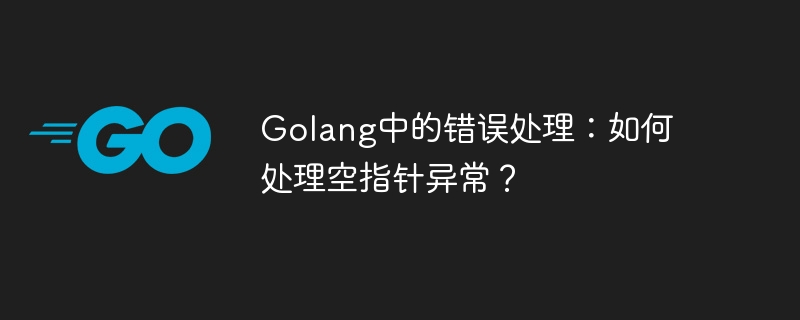Home >Backend Development >Golang >Error handling in Golang: How to handle null pointer exception?
Error handling in Golang: How to handle null pointer exception?
- PHPzOriginal
- 2023-08-09 12:33:062901browse

Error handling in Golang: How to handle null pointer exception?
When programming in Golang, we often encounter null pointer exceptions. Null pointer exception means that when we try to operate on a null pointer object, it will cause the program to crash or an unpredictable error will occur. In order to avoid the occurrence of this exception, we need to handle null pointer exceptions reasonably. This article will introduce some methods of handling null pointer exceptions and illustrate them with code examples.
1. Use nil to determine
In Golang, nil represents a null pointer. Before operating on the pointer, we can avoid the occurrence of null pointer exception by determining whether the pointer is nil. The following is a sample code:
package main
import "fmt"
func main() {
var ptr *int
if ptr != nil {
fmt.Println("指针不为空")
} else {
fmt.Println("指针为空")
}
}In the above code, we declare a null pointer ptr and determine whether the pointer is null through an if statement. If the pointer is null, output "Pointer is null", otherwise output "Pointer is not null".
2. Use error return
Functions in Golang can return multiple values. When handling null pointer exceptions, we can use the return value of the function to determine whether an exception has occurred. Here is a sample code:
package main
import (
"errors"
"fmt"
)
func getValue() (int, error) {
var ptr *int
if ptr != nil {
return *ptr, nil
} else {
return 0, errors.New("发生了空指针异常")
}
}
func main() {
value, err := getValue()
if err != nil {
fmt.Println(err)
} else {
fmt.Println(value)
}
}In the above code, we define a function getValue(), which returns an integer and an error. Inside the function, we return the corresponding value and error information by judging whether the pointer is null. In the main function, we determine whether a null pointer exception occurs by obtaining the return value of the function and handle it accordingly.
3. Use panic and recover
When a null pointer exception occurs, we can also use panic and recover to handle the exception. Panic is the keyword that raises exceptions in Golang, and recover is used to catch and recover from exceptions. The following is a sample code:
package main
import "fmt"
func main() {
defer func() {
err := recover()
if err != nil {
fmt.Println("发生了空指针异常")
}
}()
var ptr *int
fmt.Println(*ptr)
}In the above code, we define an anonymous function using the defer keyword. In this function, we use recover to catch exceptions and output error information when an exception occurs. In the main function, we try to get the value of the null pointer, which will cause the program to crash. But because we use defer and recover, the program will continue to execute after the panic occurs instead of crashing immediately.
Summary:
Handling null pointer exceptions is one of the important error handling skills in Golang. This article introduces three methods of handling null pointer exceptions: using nil judgment, using error return, and using panic and recover. Each of these methods has advantages and disadvantages, and the appropriate treatment method needs to be selected according to the specific situation. By properly handling null pointer exceptions, we can effectively improve the stability and robustness of the program.
The above is the detailed content of Error handling in Golang: How to handle null pointer exception?. For more information, please follow other related articles on the PHP Chinese website!

